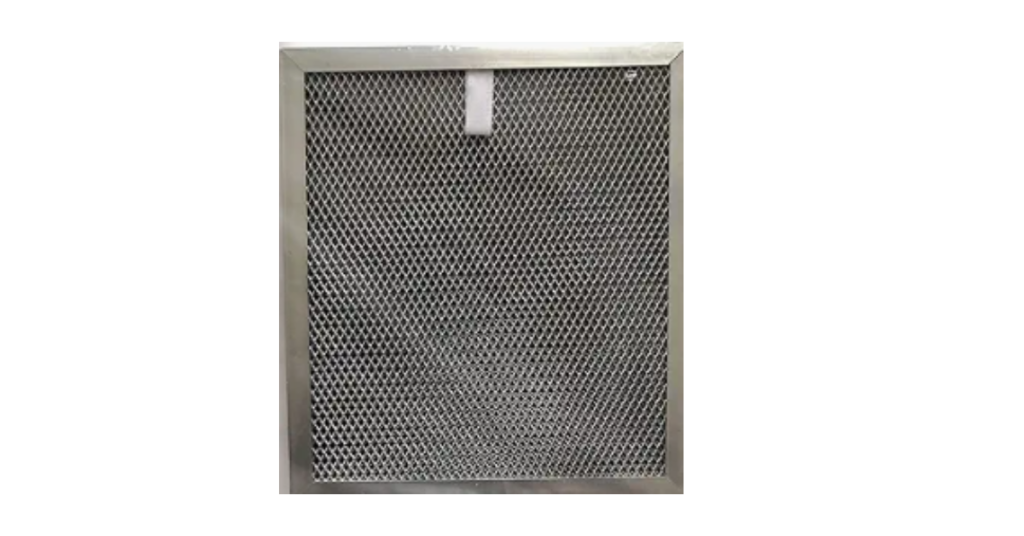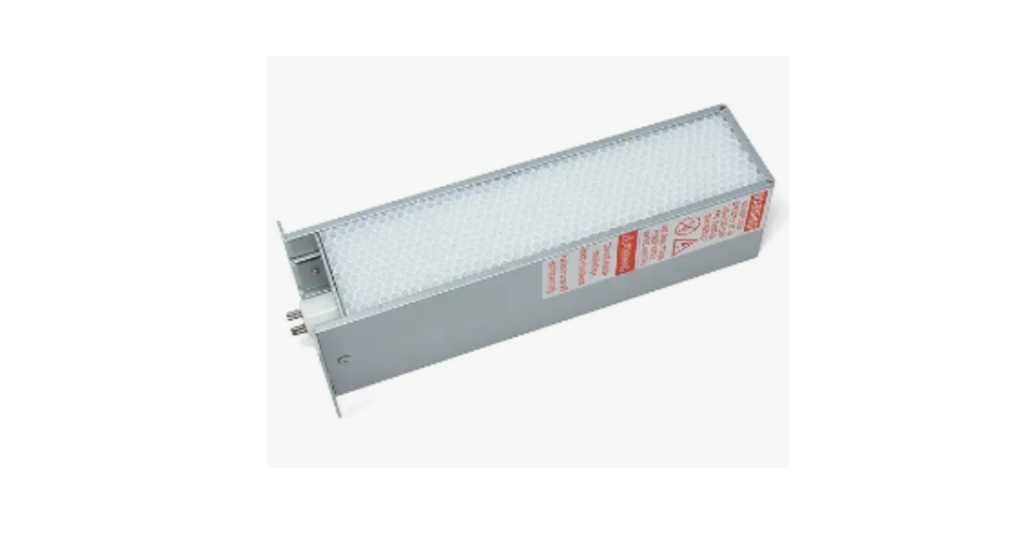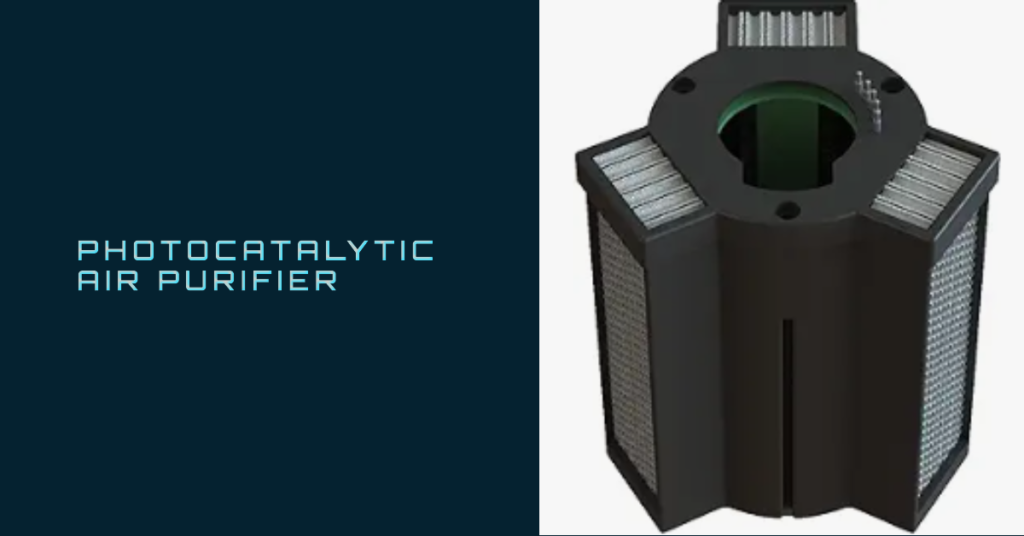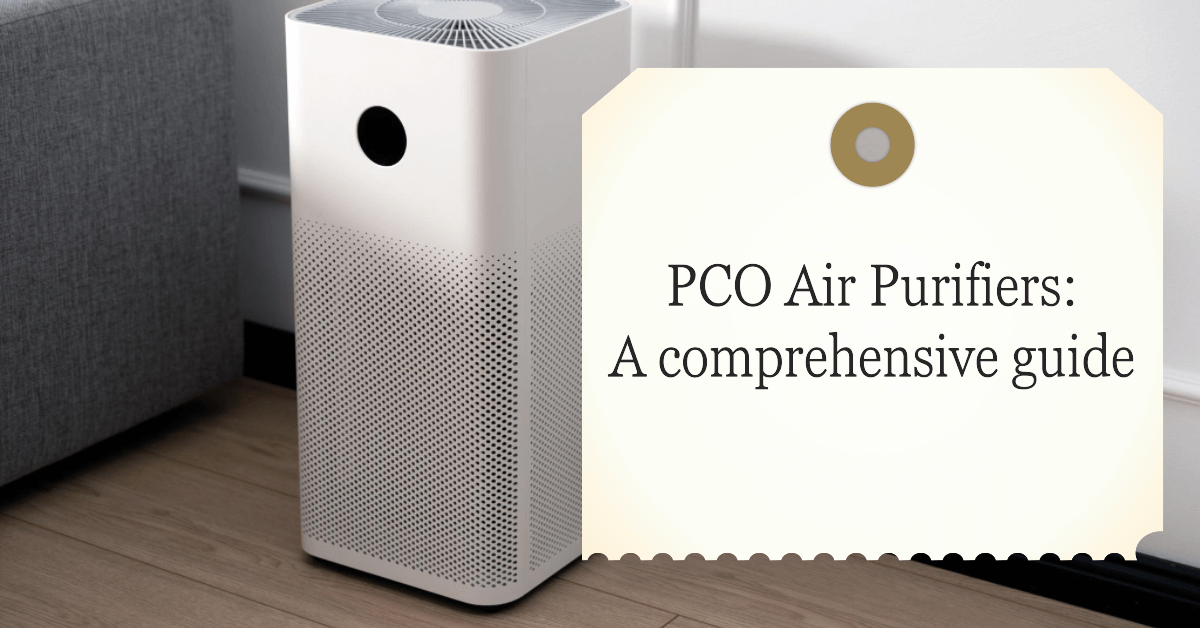PCO air purifiers are innovative devices which utilize Photocatalytic Oxidation (PCO) technology to combat indoor air pollutants, providing an effective solution to breathe cleaner and healthier air. As our understanding of the importance of indoor air quality deepens, PCO air purifiers or Photocatalytic Air Purifiers or Photocatalytic Oxidation Air Purifiers have emerged as a transformative technology that promises to clean the air we breathe in homes, workplaces and beyond.
In this simple guide, we’ll understand What aare PCO air purifiers, we’ll explore the benefits and limitations of these devices, making it easier for you to make informed decisions about improving your indoor air quality.

What’s a PCO Air Purifier?
Let’s break it down. PCO stands for Photocatalytic Oxidation. A PCO air purifier is a type of air cleaner that uses a combination of UV (ultraviolet) light and a photocatalyst. to clean the air.When light shines on this PCO air purifier, it triggers a chemical reaction that zaps away nasty stuff in the air, like bacteria, viruses, and even odors! Bye-bye, bad smells! At the heart of PCO air purifiers lies the remarkable technology known as Photocatalytic Oxidation (PCO).
How PCO Air Purifiers Work
PCO air purifiers utilize photocatalysts, typically made of materials like titanium dioxide, to initiate a chemical reaction when exposed to ultraviolet (UV) light. This reaction transforms common indoor air pollutants, such as bacteria, viruses, volatile organic compounds (VOCs), and even odors, into harmless byproducts. The result is cleaner, fresher air that contributes to a healthier living environment.
When air passes through the PCO air purifier, it first encounters the filter, which removes larger particles. Then, the air enters the reaction chamber where the UV light activates the photocatalyst. This sets off a reaction that breaks down pollutants into harmless byproducts like carbon dioxide and water vapor. Finally, the purified air is released back into the room, leaving it cleaner and fresher.
Key Components of a PCO Air Purifier
A typical PCO air purifier comprises several essential components, each playing a crucial role in the purification process:
| Component | Function |
|---|---|
| Photocatalyst Coating | Initiates the photocatalytic reaction when exposed to UV light. |
| UV Lamp | Emits ultraviolet light to activate the photocatalyst. |
| Fan | Circulates air through the purifier for continuous purification. |
- UV Light: This is the star of the show. UV light is used to activate the photocatalyst, which is a substance that reacts with pollutants in the air.
- Photocatalyst: This is a material that reacts with pollutants when exposed to UV light. Common photocatalysts include titanium dioxide (TiO2) and other metal oxides.
- Reaction Chamber: This is where the magic happens. The UV light shines onto the photocatalyst, causing a chemical reaction that breaks down pollutants like bacteria, viruses, mold, and volatile organic compounds (VOCs).
- Air Filter: While not exclusive to PCO air purifiers, many models include a filter to capture larger particles like dust and pollen before they reach the reaction chamber.
- Fan: A fan is often used to circulate air through the purifier, ensuring that all the air in the room passes through the reaction chamber and filter.
These components work together seamlessly to ensure the efficient removal of indoor air contaminants, providing you with air that’s not only visibly cleaner but also healthier.


Advantages of PCO Technology
The advantages of PCO air purifiers are abundant and include:
- Comprehensive Air Purification: PCO technology is highly effective at eliminating a wide range of indoor pollutants, from allergens to odors.
- Low Maintenance: PCO air purifiers typically require minimal maintenance, with photocatalyst replacement being the primary task.
- Ozone-Free: Unlike some other air purification methods, PCO technology does not produce harmful ozone, ensuring the air remains safe to breathe.
As we move forward in this guide, you’ll discover how PCO technology has evolved over the years and how it compares to other air purification methods.

Benefits of PCO Air Purifiers
PCO air purifiers offer a multitude of benefits that make them a popular choice for improving indoor air quality. In this section, we’ll explore the advantages these innovative devices bring to your home or workplace.
Improved Indoor Air Quality
Perhaps the most compelling advantage of PCO air purifiers is their ability to enhance indoor air quality. By effectively removing a wide range of pollutants, they create an environment where the air is noticeably fresher and healthier. This improvement benefits everyone, from individuals with allergies to those simply seeking a cleaner living space.
Reduction of Harmful Pollutants and Pathogens
PCO technology doesn’t just mask odors or trap pollutants; it actively neutralizes and eliminates them. Bacteria, viruses, mold spores, and volatile organic compounds (VOCs) are broken down into harmless byproducts, leaving your indoor air not only cleaner but safer. This is especially important for maintaining a healthy living or working environment.
Health Advantages for Individuals and Allergy Sufferers
For individuals with allergies or respiratory conditions these can be a game-changer. By removing common allergens like pollen and pet dander, as well as biological contaminants, they create an environment where breathing is easier and allergy symptoms are reduced. This can lead to better sleep, improved concentration, and an overall enhanced quality of life.
| Advantage | Description |
|---|---|
| Improved Air Quality | Noticeably fresher and healthier indoor air. |
| Reduction of Pollutants | Active elimination of harmful pollutants and pathogens. |
| Health Advantages | Relief for allergy sufferers and improved well-being for all. |
| Comparison | Key Differences |
|---|---|
| HEPA Filters | PCO technology addresses gaseous pollutants and biological contaminants effectively. |
| Ionic Purifiers | Compare the mechanisms of ion-based purification with PCO technology. |
| UV-C Purifiers | Explore the distinctions and complementarity of UV-C purification and PCO technology. |

Types of Contaminants Targeted by photocatalytic oxidation air purifier
As we continue our exploration of PCO air purifiers, it’s essential to understand the types of contaminants they effectively combat. Whether you’re dealing with common indoor pollutants, biological threats, or complex volatile organic compounds (VOCs), PCO air purifiers have you covered.
Common Indoor Pollutants and Allergens
Indoor spaces can harbor a range of common pollutants, including dust, pollen, pet dander, and mold spores. For allergy sufferers and those seeking relief from these irritants, PCO air purifiers offer a solution. They efficiently capture and neutralize these airborne particles, providing much-needed relief.
Biological and Chemical Contaminants
Biological contaminants such as bacteria and viruses can pose health risks, especially in closed environments. PCO technology excels at inactivating these threats by breaking down their DNA or RNA, rendering them harmless. Additionally, PCO air purifiers tackle chemical contaminants, such as formaldehyde and volatile organic compounds (VOCs), found in household products and building materials.
Complex Volatile Organic Compounds (VOCs)
Some indoor pollutants, like complex VOCs, can be particularly challenging to eliminate. These compounds are released from sources like paint, cleaning agents, and new furniture. PCO air purifiers are effective in breaking down these complex VOCs into harmless byproducts, ensuring your indoor air remains pristine.
Common Indoor Contaminants Targeted by PCO Air Purifiers
| Contaminant Type | Examples |
|---|---|
| Allergens | Dust, pollen, pet dander, mold spores |
| Biological Contaminants | Bacteria, viruses |
| Chemical Contaminants | Formaldehyde, household chemicals |
Understanding the spectrum of contaminants that PCO air purifiers address underscores their versatility and effectiveness in enhancing indoor air quality.
Tips for Using Your Plasma Wave Air Purifier
Here are some tips to get the most out of it:
- Placement Matters: Put your purifier in a central location where it can clean the most air. Avoid blocking it with furniture or curtains.
- Keep It Clean: Just like any superhero, your Plasma Wave Air Purifier needs regular maintenance. Clean the filters and chambers according to the manufacturer’s instructions to keep it running smoothly.
- Run It Consistently: For the best results, run your purifier consistently, especially in rooms where you spend the most time, like the bedroom or living room.
- Size Matters: Make sure you choose the right size purifier for the room you want to clean. A small purifier won’t be effective in a big space, so choose accordingly.
- Give It Time: It may take some time for you to notice the difference in air quality, so be patient. Your purifier is hard at work cleaning the air, even if you can’t see it happening.
Applications of PCO Air Purifiers
PCO air purifiers find application in various settings, from homes to healthcare facilities. In this section, we’ll explore the diverse uses of these purifiers and their specific benefits in different environments.
Residential Use and Benefits
PCO air purifiers are becoming increasingly popular in residential settings. They provide homeowners with a comprehensive solution to maintain clean and healthy indoor air. We’ll delve into how they benefit families and individuals within the comfort of their homes.
Commercial and Industrial Applications
Commercial and industrial spaces have unique air quality requirements. PCO air purifiers are used in various industries to ensure the well-being of employees and the quality of products. Discover the applications and advantages of PCO technology in these settings.
Healthcare and Medical Settings
In healthcare and medical facilities, maintaining high indoor air quality is critical. PCO air purifiers play a vital role in sterilizing the air and reducing the risk of infection. Learn how these purifiers contribute to a safer healthcare environment.
Applications of PCO Air Purifiers
| Application | Specific Benefits |
|---|---|
| Residential Use | Enhanced indoor air quality for families and individuals. |
| Applications in industries to ensure employee well-being and product quality. | |
| Healthcare and Medical | Critical role in maintaining sterile air in healthcare environments. |
Conclusion
PCO air purifiers offer an effective and low-maintenance solution for improving indoor air quality. By harnessing the power of UV light and photocatalysis, these purifiers can help remove a wide range of pollutants from the air, leaving your home cleaner and healthier.
With their advanced photocatalytic oxidation (PCO) technology, these purifiers effectively reduce pollutants, allergens, and harmful pathogens, resulting in healthier and cleaner air.
While photocatalytic oxidation air purifier offer substantial benefits, they do face challenges in gaining widespread adoption, particularly in terms of consumer awareness, economic considerations, and the global demand for improved indoor air quality.
Nevertheless, the potential of photocatalytic air purifier to revolutionize indoor air quality is undeniable. As individuals and organizations become more informed about the benefits and advancements in PCO technology, we can look forward to cleaner, safer, and healthier indoor environments.
FAQ
Do PCO air purifiers work?
Yes, PCO air purifiers are effective in improving indoor air quality by using Photocatalytic Oxidation (PCO) technology to reduce various pollutants.
What is the difference between PCO and HEPA?
The main difference is in the mechanism. PCO purifiers break down pollutants chemically, while HEPA filters physically trap particles. HEPA is better for particles, while PCO can address gases and VOCs.
Are PCO filters safe?
PCO filters are generally safe when used as directed. Follow manufacturer guidelines for maintenance and replacement to ensure ongoing safety.
Does PCO produce ozone?
Yes, PCO purifiers can produce a small amount of ozone as a byproduct. Emissions are usually within safety limits, but choose PCO purifiers with low ozone output if concerned.
Are air purifiers safe for lungs?
Yes, air purifiers, including PCO purifiers, are generally safe for lung health. They can remove harmful particles from the air, benefiting individuals with respiratory conditions or allergies. Consult a healthcare professional if you have specific health concerns.
How does PCO technology work?
PCO technology, or Photocatalytic Oxidation, uses a catalyst typically made of titanium dioxide activated by UV light to break down and neutralize airborne pollutants, including VOCs and microbes.
What is the advantage of PCO?
PCO technology offers advantages such as the ability to effectively target a wide range of indoor pollutants, including VOCs, mold, and bacteria, resulting in improved indoor air quality.
What is a PCO product?
A PCO product is an air purifier or similar device that utilizes Photocatalytic Oxidation (PCO) technology to clean and purify indoor air.
DheerajSonwane is a dedicated writer with expertise in air purification technologies. He focuses on providing well-researched content to help readers improve indoor air quality in homes and businesses. As the lead writer at AirPurifierMaster.com, Dheeraj offers practical advice his insightful reviews guide individuals in choosing the best air purifiers for their needs.

